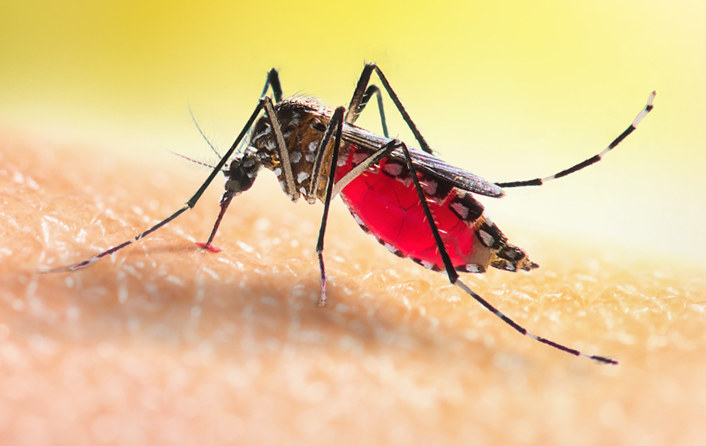
West Nile virus (WNV) arrives like clockwork annually during picnic season. As late spring and early summer bring sunshiny weather, mosquitoes awaken from their yearly slumber. WNV, the leading cause of mosquito-borne disease in the continental United States, often accompanies them. As of January 10, a total of 1,035 cases of the disease in people have been reported to the CDC.

West Nile virus (WNV) arrives like clockwork annually during picnic season. As late spring and early summer bring sunshiny weather, mosquitoes awaken from their yearly slumber. WNV, the leading cause of mosquito-borne disease in the continental United States, often accompanies them. As of January 10, a total of 1,035 cases of the disease in people have been reported to the CDC.
At its worst, this virus can become neuroinvasive (meningitis or encephalitis), with 1 out of 150 infected people developing a serious, sometimes fatal, illness. Symptoms range from headache, high fever, neck stiffness, and muscle weakness to tremors, seizures, paralysis, and even death.
To date, there are no human vaccines to prevent the disease. Nor, at present, are there any medications to treat it. Crystal Hepp, Ph.D., a disease ecologist, trained evolutionary biologist, and genomics researcher with TGen North, TGen’s Pathogen and Microbiome Division, hopes to mitigate the impact of WNV by targeting endemic mosquito populations before they take off and grow.
Hepp’s lab focuses on using environmental surveillance and network analysis of pathogens, especially viruses, to understand their spread over time and space. “Through genomic analyses, we realized that the endemic variant circulating currently in Maricopa County entered in about 2010. The hope is that some sort of mitigation, like targeted insecticide applications at particular trap locations, can knock down the mosquito population before it results in high human caseloads.”
This is the goal: track the origins of the endemic population, target them at their home location, and intervene to save lives.
Discovering a Passion for Virus Hunting by Number
Hepp grew up in a rural farming community. Her interest in science drove her toward a career in medicine. “Initially, I thought that I wanted to go to medical school,” she explains because, in her small-town community, most folks interested in science follow that path. Instead, she pursued a degree in Microbiology at Montana State and worked in a bioinformatics lab, funded by the Federal Work-Study program that provided assistance for students in need. The work focused specifically on RNA viruses—WNV is a single-stranded RNA virus that causes West Nile fever—but at the time, her work had a different orientation.
“From an academic perspective, we were trying to better understand the evolution of a variety of viruses, from rabies to HIV,” Hepp says of how the Lab influenced her trajectory, “That’s kind of how it started.”
She learned quickly that she had more of a passion for data analysis than she did the lab work, but she wasn’t clear on how all of these pursuits might converge. Dr. Sudhir Kumar, a pioneer in the intersection of evolutionary and computational biology, encouraged her to apply to Arizona State University (ASU) with the prescient advice, “You’re gonna find something that you really enjoy.”
She did.
In 2008, she started a unique grad program in molecular and cellular biology combined with a concentration in computational biology. She was the only student to take advantage of the coursework involved in the concentration program. From there, Hepp traded Phoenix for Flagstaff, graduating from ASU to do a postdoc with the Pathogen and Microbiome Institute at Northern Arizona University.
“We worked on a variety of pathogen investigations, primarily focusing on bacteria during my postdoc. Two years later, I got a faculty position at Northern Arizona University and transitioned back to viruses,” Hepp explains.
Per the advice of Maricopa County Environmental Services, Hepp focused the attention of her lab on WNV, searching for particular hot spots that genomics could help them identify. The virus was circulating in Arizona and throughout the Southwest.
It was an urgent concern, growing year after year.
Following Mutations Across Time & Space
Viruses can be tracked using genomic sequencing data. Studying viral genomes provides insight into the evolution of mutations over time. Hepp’s lab has sequenced nearly 1000 different genomes of the WNV, which has led to identifying hot spots and tracking its origins.
“The first thing we were able to show is that WNV is actually endemic, and so it isn’t being imported into the county each year,” Hepp explains. “It actually stays in Maricopa County, overwintering, and reemerging when conditions are ripe for mosquitoes to start breeding again. At the same time, Culex mosquitoes start taking blood meals from birds, a major amplifier host for WNV, perpetuating a cycle which can drive up the environmental viral load.”
This means that as we understand WNV in Maricopa County, it isn’t a matter of if it is going to reemerge every year, it is a matter of when.
“Within the county, what we’re hoping is that in identifying highly connected locations that are important for maintaining the enzootic cycle, this research will lead to mitigation activities at those locations, and drive down not only the number of infected mosquitoes but also, the number of human cases.”
Hepp’s team is in the process of sharing these research protocols nationwide as part of her activities as a co-lead on the CDC funded Pacific Southwest Regional Center of Excellence in Vector-Borne Diseases.